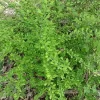X
CONTACT US
Great Lakes Center, SAMC 319
SUNY Buffalo State
1300 Elmwood Ave., Buffalo, NY 14222
wnyprism@buffalostate.edu
(716) 878.4708
SUBSCRIBE TO LISTSERV
FOLLOW US
CONTACT
Japanese Barberry
COMMON NAME:
Japanese barberrySCIENTIFIC NAME:
Berberis thunbergiiORIGIN:
JapanDESCRIPTION:
Japanese barberry is a deciduous shrub that can grow 8 ft. tall. It has grooved stems with single or paired thorns in the nodes. Its leaves are ½“ to 1 ½” in length and grow in irregular clusters. In April and May, japanese barberry produces umbrella-shaped clusters of white flowers on the undersides of its branches. The red, oblong fruit are produced in September.HABITAT:
Japanese barberry is drought resistant, and survives in both full sun and full shade, allowing it to invade a variety of habitats. It is common to see barberry forming dense thickets on forest floors, though it will also grow in open areas and disturbed sites.THREAT:
Japanese barberry has been linked to Lyme disease. In areas with large infestations of japanese barberry, there may be a 90% increase in Lyme-disease-carrying ticks when compared to areas with native shrubs. This is likely due to the fact that japanese barberry provides excellent cover for deer mice, the larval deer tick’s host, and helps retain humidity, making it an ideal habitat for ticks. Japanese barberry has also been linked to increases in invasive earthworm populations and in soil erosion.MANAGEMENT:
Smaller shrubs can be pulled. Larger shrubs and infestations can be treated with herbicides. Herbicides may be applied to japanese barberry in early spring and late fall, when native plants are dormant. Plants may be foliar sprayed or treated using cut-stump methods.
WNY PRISM PRIORITY:
WNY PRISM Priority
Tier 4 - Local Control
ADDITIONAL RESOURCES:
There are no additional resources at this time.NYS Prohibited and Regulated Species - Part 575:
PATHWAYS OF INVASION:
Pathways
Japanese barberry was introduced to the United States as an ornamental plant. It spreads by seed and by vegetative means.
Japanese barberry is a prohibited species in New York State - for more information on Prohibited and Regulated Species, visit http://www.dec.ny.gov/animals/99141.html.
Native Alternatives
Ninebark (Physocarpus opulifolius)
Northern spicebush (Lindera benzoin)
Black chokecherry (Aronia melanocarpa)
REGIONAL DISTRIBUTION:
Regional Distribution
Widespread





